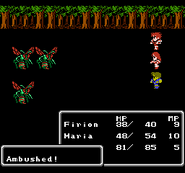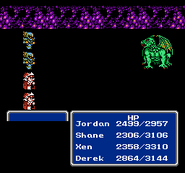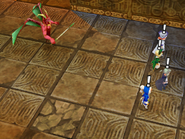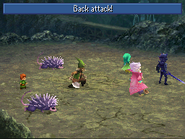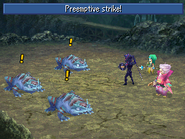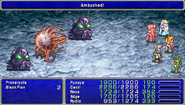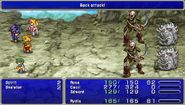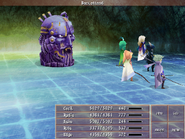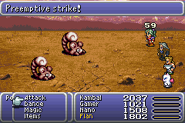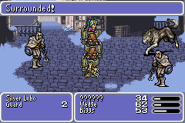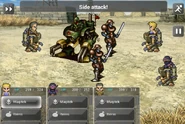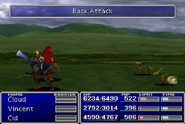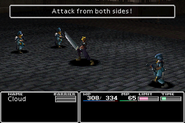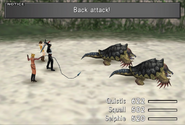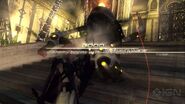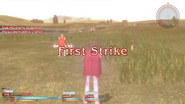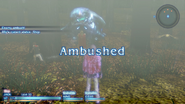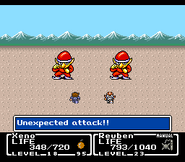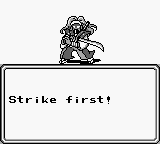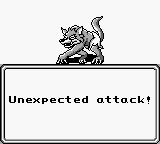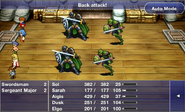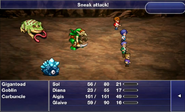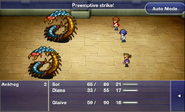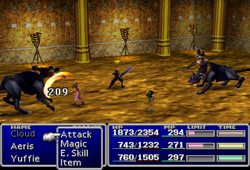
A pincer attack in Final Fantasy VII.
Attack formations are the types of battle formations that an encounter can begin with in games where battles take place in a different plane than field gameplay. It usually determines who gets to attack first.
Types[]
- Normal formation: Player characters and opponents have an equal shot at getting the first turn.
- Preemptive attack: Sometimes also called First Strike, Strike First, and Preemptive Strike. The player party gets to strike the enemy first, and the characters' ATB gauges always start filled up. In later titles, the enemies face away from the party members, allowing physical attacks to deal double damage for one turn.
- Surprise attack: Sometimes also called Ambushed, Surprised, and Sneak attack. The enemy gets a chance to strike the party first, and the party's ATB gauges start empty.
- Back attack: Sometimes also called Attacked from behind. This is similar to the surprise attack, except the party is attacked from behind and each character is in the opposite row. For example, a physical fighter in the front row would be placed in the back row.
- Side attack: The party surrounds the enemy, with two members lining up on each side of the battle screen (or two and one if there is a three-character party). Any party member who hits an enemy with a physical attack while its back is turned deals extra damage. Most spells that target all allies will only target allies on the same side of the battlefield. All characters' ATB gauges start filled up. Some fights, such as the Goddess in Final Fantasy VI, are always side attacks. Side attacks only appear in Final Fantasy VI and Final Fantasy VII, although the battle against Tros in Final Fantasy X also features a side attack formation.
- Pincer attack: Sometimes also called Surrounded. The party is surrounded by the opponents and characters' ATB gauges start out empty. Any character physically struck from behind takes more damage, and spells that usually affect all opponents only affect those on one side of the battlefield. During a pincer attack, the party cannot flee. Some fights, such as the Cranes in Final Fantasy VI, are always pincer attacks. Pincer attacks only appear in Final Fantasy VI and Final Fantasy VII.
- Turn-Based attack: Prominent in Final Fantasy Tactics and Final Fantasy Tactics Advance. Both teams start with a number of members and, when the battle begins, the fastest unit goes first and so on down the line. Faster characters usually get more turns than slower ones. The accuracy of an attack is determined by which direction the unit attacks the target from (side and back attacks are more accurate than ones from the front). Final Fantasy X somewhat follows this formation.
- Brave attack: In Bravely Default, it means the battle starts with an additional Brave Point.
Appearances[]
Final Fantasy[]
Final Fantasy II[]
Final Fantasy III[]
Final Fantasy IV[]
In a normal encounter, characters begin in their normal rows and their ATB gauges begin depleted and instantly begin filling. In a preemptive strike, the ATB gauges begin filled. In a surprise attack, their ATB gauges begin empty and do not begin to charge until all enemies have attacked. If the party is attacked from behind, their rows are reversed and their ATB gauges begin empty and will not charge immediately, as in a surprise attack. Uniquely, the second battle with Scarmiglione (2D and 3D) is always a back attack.
Final Fantasy IV -Interlude-[]
The same attack formations returns in the sequel of Final Fantasy IV. It function is no different from the original.
Final Fantasy IV: The After Years[]
Like the previous two titles, the attack formations function the same way as they did previously.
Final Fantasy V[]
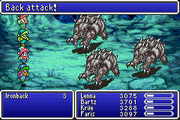
Back Attack.
Not all enemies can be preempted; it depends on the enemies and their pre-coded battle formations. Some enemies always back attack the party unless they have the Thief's Caution ability equipped. The Ninja learns First Strike, which doubles the party's chance of a preemptive strike from 32/256 (or 1/8) to 64/256 (or 1/4). If the party is back attacked, they can use the Return spell to start the battle over, usually without the back attack.
Final Fantasy VI[]
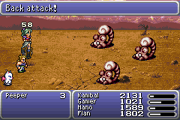
Back attack.
Final Fantasy VI has three types of special formations: Back attack, side attack, and surrounded (pincer attack), where it introduces side and pincer attacks. Most enemy formations allow all types of battle formations, though some disable certain formations. Boss battles typically use normal formations, though some, such as Goddess, use side attacks.
Surrounded and back attacks will never be preemptive strikes. For a normal attack, there is a 1/8 chance of a preemptive strike. Side attacks have a 7/32 chance of being a preemptive strike. If any character is equipped with a Gale Hairpin, the chances are doubled. Certain enemy formations (mostly bosses) disable preemptive strikes altogether.
If any character is equipped with an Alarm Earring, pincer and back attacks are disabled (except when fighting Tyrannosaur). If Gau is learning a new Rage on the Veldt, he will not return to the party in a side, back, or surrounded attack.
Final Fantasy VII[]
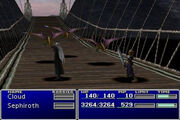
A normal formation.
Final Fantasy VII has three types of special formation battles, similar to those in Final Fantasy VI: Back Attack, Side Attack, and Ambush (Pincer Attack). In Back Attacks, the player's party starts facing away from the enemy (unless equipped with Sprint Shoes) and thus takes double damage from the first attack, with the normal formation reversed (party members in the back row start in the front row, and vice versa). In Side Attacks, the party is cut in half and surrounds the enemy in the middle. In Ambushes, the opposite happens, with the enemy surrounding the party.
The same rules with rows apply as in other games: characters in the back row deal and receive half physical damage, while characters in the front row receive full damage. Any long range attacks, Limit Breaks, magic, summons, items and some abilities are unaffected. In addition to this rule, attacking an enemy facing away from the party will cause that attack to deal double damage, though that enemy will then turn to face the party. The same is true of the opposite, as enemies in a Back Attack or Ambush can hit a party member from the back and deal double damage. Certain bosses take more damage from the back than usual.
Equipment can be acquired to help deal with disadvantageous special formations. Sprint Shoes guarantees that the player is never facing away from an enemy in Back Attacks. More importantly, a mastered Pre-Emptive Materia halves the chance of a Back Attack or Ambush ever occurring, while increasing the chance of a pre-emptive attack.
Cait Sith's Slots has two outcomes that usually end the battle: Death Joker and Game Over, that kills all allies or all enemies, respectively. In a Side Attack or Ambush, however, these can only target one enemy or ally party.
The game has a cosmetic glitch involving the Ambush formation: when pincered by two Allemagnes and the player manipulates one and makes it defeat itself via L4 Death, its battle model does not disappear.
Final Fantasy VIII[]
A preemptive strike can occur for either side, announced as either "Chance for first strike!" for the party or "Struck first!" for enemies. The benefiting side starts with full ATB gauges, while the vulnerable side starts with empty gauges, though they will still fill normally. Back attacks can also occur, which function similarly, though the vulnerable side will also start the battle faced away, causing targets to take double damage and turn around if struck by a physical attack. A back attack in the party's favor is announced as "Back attack!" while "Back attacked!" is announced for enemies. Enemies will not always attack right away when back-attacking the party. Although Imps and Cactuars face forward during a back attack, they will still take additional damage.
The player can prevent enemy preemptive strikes and back attacks and increase the chances of performing them in return with Cerberus's Alert ability, although it does not protect against the second fixed Ruby Dragon battle at the Deep Sea Research Center before fighting Bahamut. Some enemies cannot be struck preemptively or back-attacked without Alert equipped. Odin and Gilgamesh can appear regardless of attack formation.
Final Fantasy IX[]
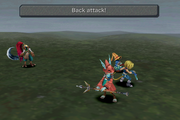
Back Attack.
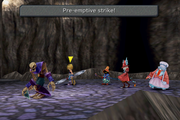
Preemptive Strike.
In a back attack, the enemy ambushes the player party. The party's rows are inverted and the enemy starts with full ATB whereas the party starts with none. The party starts facing away and physical attacks to their backside deal more damage. They turn around when attacked, or they get their first turn.
In a pre-emptive strike, the player starts with full ATB on all party members whereas the enemy, that is facing away, starts with none. Physical attacks to the enemy's backside deal more damage.
Freya can learn the Initiative support ability that boosts the party's chance to get a preemptive strike from 16/256 (or 1/16) to 85/256 (or ~1/3).[1]
The Alert ability removes the chance of back attacks from 24/256 (or 3/32) to 0%.[1]
Zidane's ability What's That!? can be strategically used to have enemies turn around, allowing for constant back attacks.
Back-attacking 30 times in the Steam version earns the Backstabber achievement.
Final Fantasy X[]
Without the Initiative ability, there is a 12.5% chance of being Ambushed, and a 12.5% chance of getting a Preemptive strike. With Initiative, there is a 25% chance of a Preemptive strike and all Ambushes are eliminated (except certain enemy encounters), as long as the character with Initiative is in the active party. The player can use the First Strike ability to always get a turn first, even while being ambushed. This is especially useful because characters can be swapped during battle.
Three enemies always ambush the party regardless of equipment: the Great Malboro (Omega Ruins and Monster Arena only), the Malboro Menace, and the first battle against Dark Yojimbo.
During the opening sequence, the party is pincered by Sinscales and has to defeat the ones in front of them to proceed. Later, in the Tros battle, the player can use a Trigger Command called Pincer Attack to surround the boss from both sides.
Final Fantasy X-2[]
Final Fantasy XIII[]
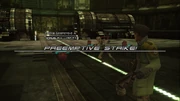
Lightning leading a preemptive strike.
The player can begin a battle with a preemptive strike by engaging enemies before an exclamation mark appears above them, indicating the player has been noticed. Engaging enemies outside of their battle zones, however, will not count as a preemptive strike. Unlike other games, enemies cannot ambush the party.
When a preemptive strike takes place, the party leader starts with a full ATB bar, and all enemies have their chain gauges filled up to roughly 95% with a 10 second chain duration. The preemptive strike animation at the start of a battle, in which the party leader strikes each enemy individually to fill their chain gauges, does not add to the target time. Getting a preemptive strike also multiples the battle score by 1.2.
Chapters 4 and 10–12 feature three-way battles, in which two groups of enemies are engaged with each other. If said enemies do not detect the party, a preemptive strike will occur, and the enemies may concentrate on each other until one side is dead before attacking the player party. In these battles, area-of-effect abilities and Quake will only hit one group.
The player can use a Deceptisol to make themselves invisible to enemies, and thus always get a preemptive strike. Enemies in the oretoise and ochu families, as well as Raktavija, are exceptions, as preemptive strikes are not possible against them.
Final Fantasy XIII-2[]
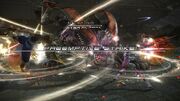
Serah and Noel launching a preemptive strike.
A preemptive strike is performed using a new gameplay element called Mog Clock. Both Serah and Noel will attack the surprised enemies in a preemptive strike with a wide slash. These battles begin with full ATB gauges for the party as well as Haste, but the enemies' chain gauges will only fill up to 120.0%.
Starting a battle with a preemptive strike 50 times earns the Quick Draw achievement/trophy, and if the player gets 100 consecutive preemptive strikes with the Mog Clock, they earn the Clock Stopper achievement/trophy.
Lightning Returns: Final Fantasy XIII[]
Enemies appear on the field and the player can strike at them as long as they have not depleted their action meter by sprinting for too long. If the player strikes an enemy after being spotted, they start the battle at "Good" battle condition and the enemy starts with 10% of their HP already lost. If the player strikes an enemy before being spotted, they start the battle at "Great" battle condition and the enemy starts with 25% of their HP already lost. If the player comes into contact with an enemy without striking them with their weapon, they are considered to have been ambushed, and start the battle with 5% of their HP lost.
Final Fantasy Type-0[]
Random battles engaged on the world map can start as ambushes or as first strikes, in the addition to normal engagements. If the party pre-emptives the enemies, either the opponents start with a disadvantage (such as with Killsight on them, dying in one hit if one is fast to hit them) or the player party begins with a random buff. If the enemies ambush the party, either the opponents start with an advantage (such as the Rage status) or the party starts with a disadvantage (such as the Killsight or Stop status). If the option to replay the battle against higher level enemies comes up, the attack formation from the first battle does not carry over.
Final Fantasy Mystic Quest[]
Certain battles will always constitute an Unexpected Attack or a Strike First. A certain Battlefield north of Focus Tower consists entirely of Unexpected Attacks.
The Final Fantasy Legend[]
Any unit with the Stealth, Warning, or Forseen (sic) skills may give the first attack to its party. Because of space limitations and translation errors, this is displayed as
"[LPMU] initiate an attack" or "Enemy initiate an attack", where LPMU is the name of the lead unit. This is the only advantageous formation possible.
Final Fantasy Legend II[]
Random battles have a chance of starting with either a Strike First or an Unexpected Attack.
Final Fantasy Legend III[]
Random battles have a chance of starting with either a Strike First or an Unexpected Attack. It should be noted that boss battles can also start a battle with an Unexpected Attack. Strike First and Unexpected Attack are governed by the party's average level versus the enemy's average level. If the party's average level is higher, First Strike will occur more frequently. If the party's average level is lower, Unexpected Attack will occur more frequently.
Final Fantasy Dimensions[]
Citations[]
- ↑ 1.0 1.1 Rebirth Flame (n.d.) . Final Fantasy IX – Battle Mechanics Guide. GameFAQs. Archived from the original on 16 June 2021.


